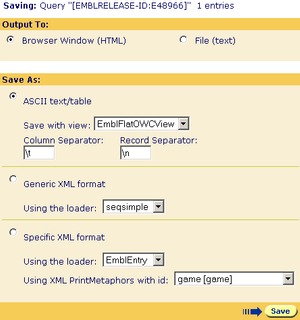|
|
Figure 19.1 Download Options page.
- In the Output To: area select the Browser Window (HTML) option in order to see what the XML data will look like before saving it to a file.
- In the Save As: area choose Generic XML format: or Specific XML Format:.
Note: The generic XML format will mimic the structure and naming conventions of the loader you have selected.
- Choose a loader from the Using the loader: drop-down list.
Note: If you are using Specific XML Format: then the loader you choose must either be the main loader for the entries of interest (e.g. EMBLEntry for EMBL, GenbankEntry for Genbank, SwissEntry for Swiss-Prot, etc.) or a special loader created to support XML data format conversions.
- If you are using Specific XML Format: choose a unique id for the set of XML PrintMetaphor objects to be used in the conversion process from the Using XML PrintMetaphors with id: drop-down list. The values presented in the drop-down list consist of the unique id followed by the name of the format's entry-delimiting element in square brackets.
- Click the
 button. The XML-formatted data will appear in the browser window. button. The XML-formatted data will appear in the browser window. - If the data formatting is acceptable and you wish to write the XML-formatted data to disk, return to the DownLoad Options page, select the File (text) option from drop-down list in the Output To: area, reselect the required XML formatting options and click the button again. You will be prompted for the name and location of the output file.
|
 button, which will take you to the DownLoad Options page.
button, which will take you to the DownLoad Options page.
 button. The XML-formatted data will appear in the browser window.
button. The XML-formatted data will appear in the browser window.